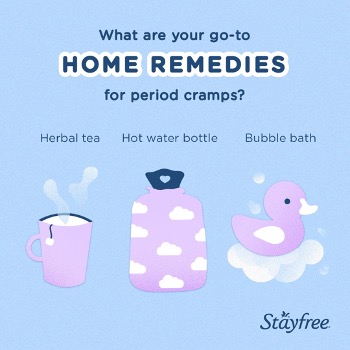How To Reduce Period Pain
When it comes to that time of the month, the pain might become unbearable for some women. In fact, for some - especially those with hormonal issues - it can be an especially difficult time. Luckily, women were built to be warriors, who have long fought the battles of period pain since the dawn of time. Through a combination of age-old remedies and modern methods, we too can overcome these battles going forward.
How to reduce period pain at home using heat
A personal favourite of many women is none other than the great hot water bottle. This is probably one of the most commonly used methods to reduce inflammation causing bloating and pain.¹ Not only does heat help with pain, but it also offers a sense of comfort, in a situation that can sometimes leave you feeling misunderstood, miserable or alone. Another form of heat commonly used for pain during PMS, are heating pads. These are electric and therefore a little more pricey, making them less common than our trusty old friend, the hot water bottle. Lastly, relaxing in a hot bath is a wonderful way to both heat up your body, and reduce stress at the same time.
home-remedies-period-pain.jpeg

Rest, rest, rest!
There’s nothing quite like taking a comforting nap or curling up in bed with a feel-good movie or a good book when you are feeling down. Be kind to yourself during this time and don’t make yourself feel bad for needing downtime.²
In fact, taking time to relax can be paramount. Stress makes everything a lot worse because it releases the stress hormone called cortisol.³
Too much of this hormone can mess with your other hormones, and affect your mood as well as your cycle.
Furthermore, researchers have actually found direct links between stress and an increase in pain and fatigue during your period. Stress also causes more bloating, as it increases inflammation.³
How to reduce PMS symptoms through your diet
Your diet, especially during the time of your period, can have a positive or negative influence on your mood, energy, and pain levels.¹ For example, replacing caffeine and alcohol with water or a soothing herbal tea like chamomile can help to relax you and reduce bloating. In addition, foods high in sugar can send you tumbling into a cycle of moodiness and fatigue.
How to reduce period pain using natural supplements and oils
Some people prefer natural remedies to reduce period pain. Supplements or foods high in magnesium, omega-three, curcumin, and potassium can all help with pain management. Furthermore, natural oils like mint, CBD and castor oil can be massaged into your pelvic area to reduce pelvic pain and tension.¹ As fatigue can be another symptom of a painful period, you could also try using lavender and valerian extract to calm you and help you get some much-needed rest.
Exercise to reduce period pain
Exercise might be the last thing you feel like doing when you’re on your period, but it will make you feel better once you get into the flow of things. All forms of exercise release feel-good hormones called endorphins, whether it be a slow walk in nature or a light jog around the block. Not only can they improve your mood, but they can also reduce pain by relaxing your pelvic floor muscles.² Bear in mind though that certain exercises like running can cause your muscles to tense, causing cramping and further pain. For this reason, low-intensity exercises are best. A great example of a pain-reducing exercise is yoga, as it works to open your hips and relax your pelvis.²
Wardrobe changes to reduce pain and discomfort
Sticking to loose-fitting clothing where possible can reduce pain, as restrictive clothing can actually disrupt blood circulation, cause irritation, infections and even increase inflammation.⁴
Painkillers
NB: Always consult a pharmacist before taking any medication so that they can guide you on what’s best for you.
This is one of the most commonly used methods when easing period pain. Although it’s not a good thing to rely on painkillers too often, they can really save the day when you’re not in the comfort of your home, or when nothing else seems to be working. When you do use painkillers, opt for the ones which contain anti-inflammatory properties, as well as help to ease your muscles.¹ When your pelvic muscles are relaxed, you’ll experience less cramping and therefore, less pain. Some people prefer only to take painkillers during their heavier flow, whereas others experience pain throughout the cycle.
Source:
- [1] https://www.everydayhealth.com/treatment/womens-health/ways-to-relieve-period-cramps/
- [2] https://helloclue.com/articles/cycle-a-z/period-cramps-101-why-menstrual-cramps-and-pain-occur-and-how-to-relieve
- [3] https://www.premierhealth.com/your-health/articles/women-wisdom-wellness-/beware-high-levels-of-cortisol-the-stress-hormone#:~:text=As%20your%20body%20perceives%20stress,alive%20for%20thousands%20of%20years
- [4] https://www.healthshots.com/intimate-health/feminine-hygiene/4-damn-good-reasons-why-your-vagina-hates-thong-panties/
